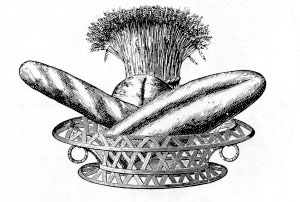Fannie Farmer’s third bread
Fannie Farmer’s third bread bears a striking resemblance to its close cousin Boston brown bread which, however, is a steamed pudding. The usage of ‘third’ does not refer to miss Farmer’s sequence of creation or preference but rather to the three grains that go into the dough. Third, or in older usage ‘thirded,’ is the oldest indigenous New England style of bread. It dates to the seventeenth century, when the early settlers found the climate very nearly inhospitable to wheat. They needed to stretch their prized but meagre crop so combined it with heartier rye and hardier corn. Those were not originally grains of choice but New Englanders came to relish their thirded breads as emblems of a proud regional identity.

- a packet of bakers’ yeast dissolved in 2 cups lukewarm water
- 1 cup cornmeal
- 1 cup rye flour
- 3 cups white flour
- ½ cup molasses
- 1½ teaspoons salt
- butter for greasing a bread loaf pan or pans.
Preheat the oven to 375°.
- Mix everything together, cover the dough and allow it time to rise to about double the original size.
- Beat down the dough with some degree of sadism, recover it and let it double again.
- Bake the bread until a thump elicits a hollow sound, usually in about forty to forty five minutes.
- Set the pan or pans on a rack to cool before turning it out.
Note:
-Miss Farmer has taken liberties with the traditional formulae for thirded bread to adapt it for Edwardian tastes. Seventeenth century thirded breads did not have set proportions of flour but would have resorted to whole wheat rather than white flour and used a much smaller proportion of it. Molasses does not appear in thirded breads, not in print anyway, until the midnineteenth century.
-Despite her vaunted precision, Miss Farmer specifies neither baking time nor temperature. The omissions are not oversights. The first edition of her Boston Cooking-School Cook Book appeared in 1896 when, she notes, “[v]arious oven thermometers have been made, but none have proved practical.” “Experience,” she therefore concludes, “is the best guide for testing temperature of oven.” [sic]
